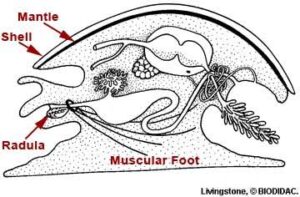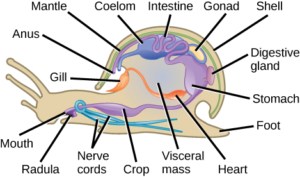Back to: ZOOLOGY 200 Level
I’m glad to have you back for another exciting learning experience. Today’s lesson focuses on molluscs—animals like snails, slugs, and octopuses. We’re going to understand how their bodies are organised, what makes their feeding tool (radula) so special, and the beauty and purpose of their shells. Let’s begin!
Body plan, radula, shell structure
Body plan of molluscs
Molluscs have a soft body that is usually divided into three major parts: the head-foot, visceral mass, and mantle.

- The head-foot includes the mouth, sensory organs, and a muscular foot used for movement or digging. In snails, for example, this foot glides along surfaces with the help of mucus.
- The visceral mass contains the internal organs such as the heart, digestive tract, and reproductive organs.
- The mantle is a layer of tissue that covers the visceral mass and often secretes the shell.
This body plan makes molluscs flexible and adaptable to land, freshwater, and marine environments.
Radula
The radula is a unique feeding structure found in most molluscs (except bivalves like clams). It is a ribbon-like tongue covered with rows of tiny teeth made of chitin.
The radula scrapes or cuts food before it enters the digestive tract. For example, in snails, the radula scrapes algae from rocks or garden leaves. In some marine snails, it’s used to bore holes into the shells of prey.
Think of it like a rough file or grater used in the kitchen—it helps molluscs process their food before swallowing.
Shell structure
The shell of a mollusc is made of calcium carbonate and is secreted by the mantle. It serves as protection against predators, harsh weather, and physical damage.

Most mollusc shells have three layers:
- The periostracum (outermost layer) protects the shell from erosion and wear.
- The prismatic layer (middle) is made of crystals of calcium carbonate and gives strength.
- The nacreous layer (inner) is smooth and shiny; in some species like oysters, it produces pearls.
Shells come in various shapes and sizes. Land snails have spiral shells, while cuttlefish have internal shells for support.
Summary
Molluscs have a soft body plan divided into the head-foot, visceral mass, and mantle. The radula is a special feeding tool used to scrape or slice food. Their shell, built from calcium carbonate, provides protection and varies in shape depending on the species.
Evaluation
- Name the three main parts of a mollusc’s body.
- What is the function of the radula, and which group of molluscs lacks it?
- Describe the three layers of a mollusc’s shell.
- How does the mantle contribute to the formation of the shell?
You’re building a strong foundation in Zoology, and lessons like this show how well-structured even the simplest animals can be. Keep up the amazing work—Afrilearn is right here to support and celebrate your learning every step of the way!
